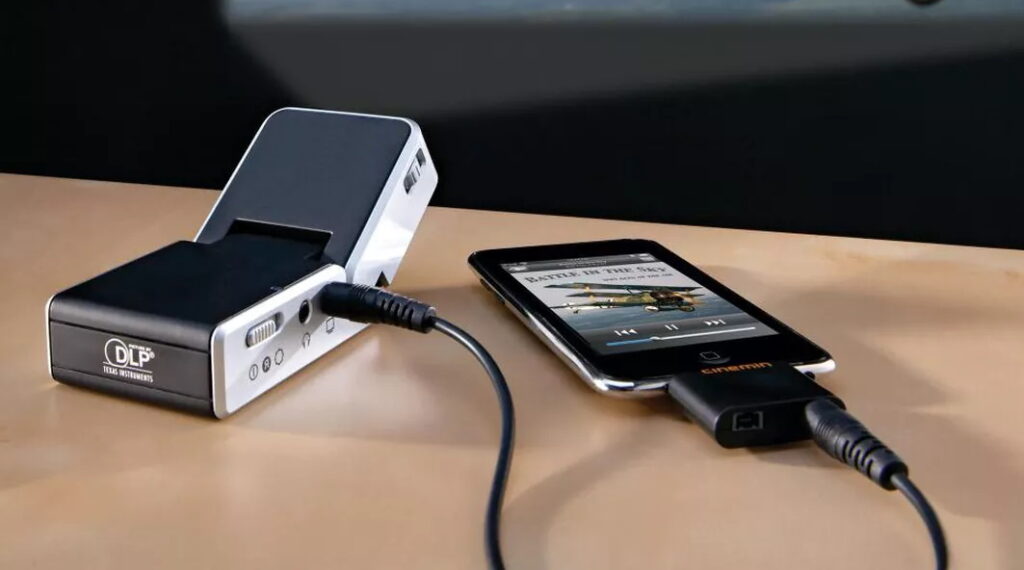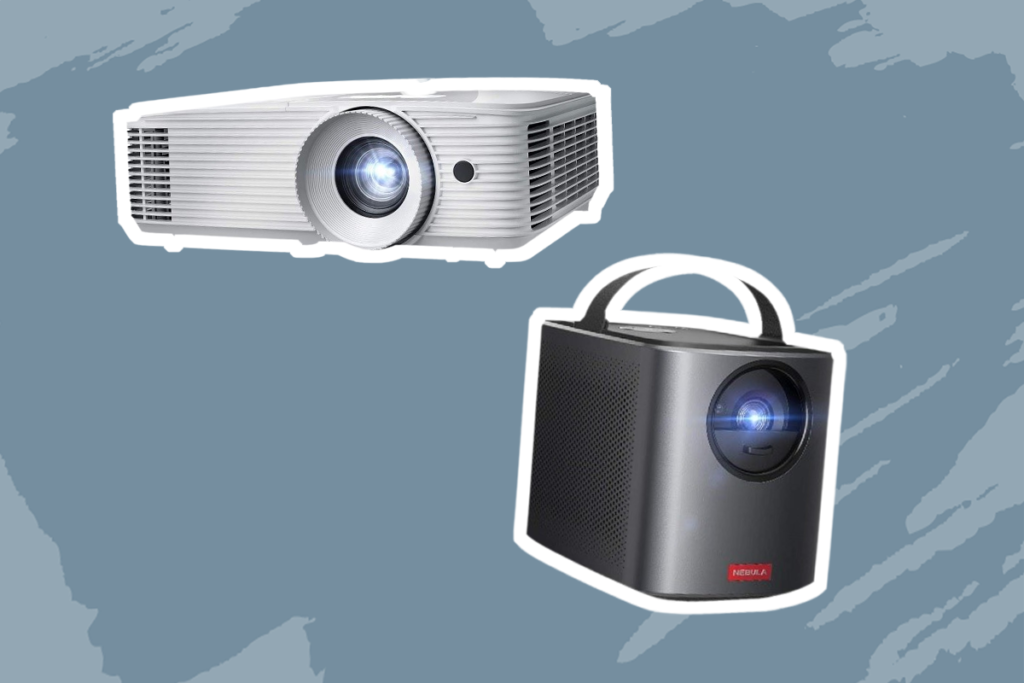Do you ever have trouble seeing your screen clearly during the day? If so, a daylight projector might be the perfect solution for you. In this article, we will review six of the best daylight projectors on the market. We will discuss their features and how they can benefit you.
We considered such factors as brightness, contrast, and throw distance that provides a clear and crisp picture during the day or night. We also included projectors that are easy to set up and have a portable design so they can be used anywhere. So, if you are looking for a way to improve your viewing experience during the day, keep reading!
More features: enhanced gaming mode, 1080p, 240Hz refresh rate, input lag 4.2ms, reduced eye strain, wall color adjustment, full 3D compatibility
The Optoma UHD38 is the best daylight projector as it is perfect for anyone looking for a bright, high-resolution picture. With 4000 lumens and a contrast ratio of 1,000,000:1, this projector is ideal for displaying clear images in any environment. The UHD38 also features a 240Hz refresh rate and 4.2ms input lag, making it the perfect choice for gamers and movie lovers. With a 33” to 300” screen size, this projector can be used in any setting. And, with a lamp life of 15,000 hours, you will enjoy years of clear viewing.
This projector is an upgrade compared to the Optoma UHD30. This UHD projector has HDR & HLG compatibility and a 1,000,000:1 contrast ratio, while the UHD 30 only has a 500,000:1 contrast ratio. The Optoma UHD38 also has a brightness of 4000 lumens which makes it ideal for lights-on viewing, while the UHD 30 only has 3400 lumens.
More features: ultra-short throw, multiple voice assistants, Smart TV, integrated speaker, blocking stray ambient light, simple to install, Filmmaker Mode™
Samsung’s The Premiere LSP7T is a top-of-the-line Smart LED projector that delivers stunning visuals and unique features. The brightness of 2200 lumens, a resolution of 3840 x 2160px, and contrast of 1,000,000:1 make this projector perfect for home theaters and business presentations. It also features ultra-short throw technology, which allows you to project a 90” – 120” image from just 9.7” – 16.3” away. And with Smart TV capabilities, voice control, and a built-in media player, you can easily enjoy your favorite movies, TV shows, and photos. Plus, the projector’s long lamp life of 20,000 hours means that you won’t have to worry about replacing bulbs anytime soon.
The Samsung 120″ The Premiere LSP7T is bigger compared to other Samsung projectors and brings the theater experience right to your doorstep. It has a contrast ratio of 2,000,000:1, which is very high compared to other models in the market. Most of them have a ratio of 1000000: 1. This projector also comes ready to stream and has a Powerful Sound 2.2 Channel System.
More features: 4K PRO-UHD1 projection technology, advanced 3LCD technology, recyclable, 3D support
The Epson Home Cinema 3800 projector is perfect for watching your favorite movies and TV shows. This projector features a 3000-lumen brightness, a resolution of 3840 x 2160 pixels, and a contrast ratio of 100,000:1, so you’ll get the ideal viewing experience. It also features 4K PRO-UHD1 projection technology and advanced 3LCD technology, ensuring clear and vivid images. The projector is also recyclable, making it environmentally friendly.
The Epson Home Cinema 3800 is a slight upgrade from the Epson Home Cinema 4010 4K. While both models have a 4K PRO-UHD, the Epson Home Cinema 3800 has a brightness level of 3,000 Lumens while the home cinema 4010 produces 2,400 Lumens. This projector is also brighter compared to the home cinema 5050 and the home cinema 5050 UBe.
More features: 1080p Full HD, short throw, integrated speaker, SuperColor™ technology
The ViewSonic PX703HD is a short-throw, high brightness projector with 3,500 lumens of color and white light output. The PX703HD features SuperColor™ technology that provides superior color performance by combining red, green, blue, and white LEDs to produce more than 1 billion unique colors. This advanced technology has the widest color gamut available in its class while delivering up to four times brighter images than competitive projectors. The PX703HD natively supports resolutions up to 1080p Full HD for stunning HD images and video quality.
The ViewSonic PX703HD is almost similar to the ViewSonic PX700HD. They both have a Full HD (1920x1080p) resolution and a screen size range of 30″-300″. They also have a brightness level of 3500 lumens and are suitable for home entertainment and gaming. However, the ViewSonic PX703HD offers more installation flexibility and has a vColor Tuner in addition to a SuperColor feature.
More features: Bright Mode, Color Management, 4K, 1080p, input lag 8ms, integrated speaker, game mode, game sound mode
The BenQ TH685 is an excellent projector for outdoor use. It has a brightness of 3500 lumens and a resolution of 1920x1080px, making it perfect for watching movies or playing games on a large screen. The contrast ratio is 10,000:1, and the lamp life is 15,000 hrs. It also has a throw distance of 30” – 380”, making it suitable for various spaces. The integrated speaker and game mode make it perfect for gaming, and the game sound mode ensures that you will hear every sound effect.
The BenQ TH685 projector is often compared with the Optoma HD146X High-Performance Projector, and it’s not hard to see why. Both projectors are within the same price range and use DLP display technology. The BenQ TH685 is, however, better as it’s supercharged with low input lag, which makes real-time gaming extremely thrilling. It’s been specifically designed for gamers, and the awe-inspiring sound will leave you fully immersed in your game.
More features: Wi-Fi connection, integrated speaker, remote control, weight: 2,2lbs, dimensions: 7.9” x 5.5” x 2.8”
The Yaber V2 is the perfect mini projector for home cinema and business presentations. It produces stunning pictures for every occasion by having a brightness of 6000 lumens, a resolution of 1280×720 pixels, and a contrast ratio of 6,000:1. It also has Wi-Fi connectivity, an integrated speaker, and remote control, making it easy to use. And with a lamp life of 100,000 hrs, it is guaranteed to provide years of reliable service.
The Yaber V2 is unique in that it’s affordable, compact, portable, and full of technological innovations. Consumers often compare it with the XIAOYA Outdoor Projector, HD Movie projector, and despite being more affordable, it’s also better in terms of connectivity technology. This projector supports WiFi, VGA, USB, HDMI, AV, and Phone. It, however, uses LED display technology, while the XIAOYA uses LCD.
Finding the right projector can be tricky without having all of this information at hand. Take our advice below if you need some help.
A projector’s brightness is measured in lumens, determining how much light shines onto your screen or wall.
A higher number of lumens means more intense projected light.
Another essential factor to consider is the resolution of the projector. The higher the resolution, the sharper and crisper the image will be. Most daylight projectors have a resolution of 1280×720 or 1920×1080 pixels, but some models offer 3840×2160 pixels resolution. If you want a super sharp image, you should look for one of these higher resolution models.
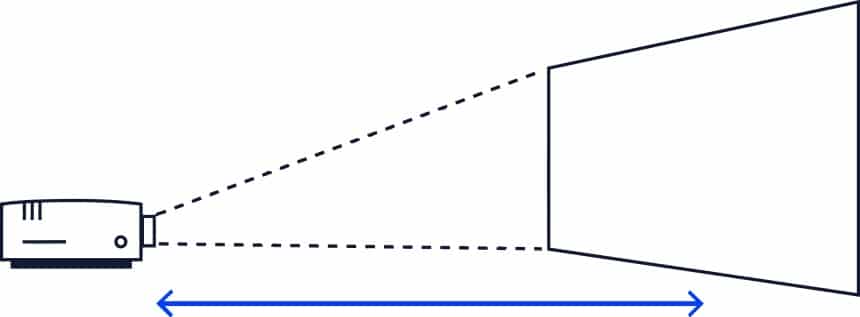
The third thing to think about is the throw distance. This is the distance between the projector and the screen or wall on which the image will be projected.
There are three different types of throw distances: standard, short-throw, and ultra-short-throw.
It would help if you also considered the available image adjustments. Many projectors have a keystone adjustment, which allows you to change the image’s shape by tilting the projector. This can be helpful if the projector is not positioned perfectly relative to the screen. You might also consider a projector with an automatic keystone adjustment, so you don’t have to worry about moving it around every time you want to use it. In addition, some projectors offer different color modes, which can be helpful for different types of content. For example, a mode optimized for viewing movies will produce darker blacks than one designed to display text.
This is the time it takes for a projector to render an image after receiving input from a device. For gaming or watching fast-paced action movies, you will want a projector with very low input lag so that there is no delay between what you see and what you are reacting to. We recommend looking for a device with an input lag of 16 milliseconds or less if you’re going to use it for video games. Check out our review on the best gaming projectors!
Next, you should think about the streaming capabilities of your projector.
Some projectors have built-in operating systems and apps for watching videos on popular services like Netflix or Amazon Prime Video without needing an external device such as Roku or Apple TV.
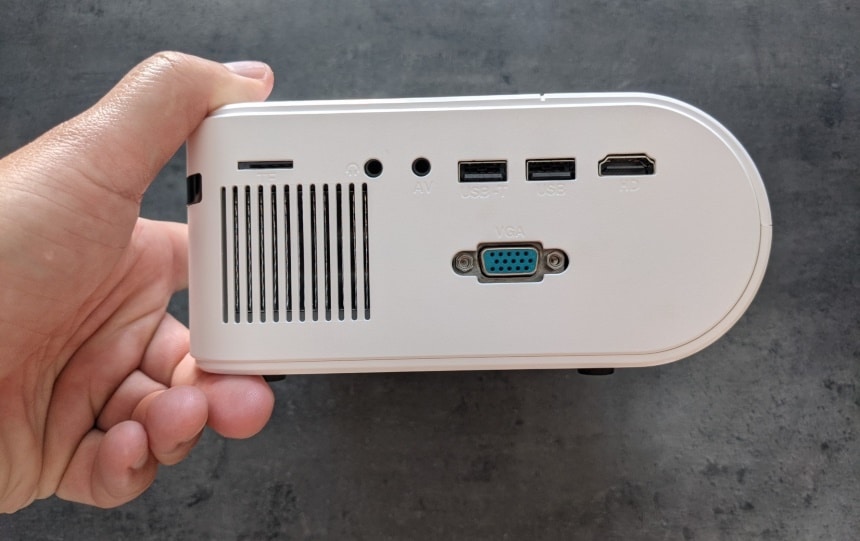
Then, think about the projector’s connectivity. This includes both the number and types of outputs available and whether they are wireless or not. Most projectors have at least one HDMI port, which can be used to connect your laptop or other devices. Having more than one HDMI port may benefit you if you plan to use multiple screens at once (such as a computer and console). Additionally, many projectors now include wireless connectivity options like Bluetooth and Wi-Fi. This can be helpful if you want to avoid using up all of the ports on your devices or if you don’t have any cables available.
Portability is another critical consideration when choosing a daylight projector. If you need a projector that you can take with you on the go, be sure to look for a small and lightweight one. Most portable projectors weigh between three and eight pounds. Our team has also looked at the best projectors for camping so that you can have a movie night with your friends in the great outdoors.
The life expectancy of projectors’ lamps ranges from 2000 to 20000 hours. However, several factors can affect how long the lamp will last. It can be usage and storage: projectors should be stored in a clean and dry place away from direct sunlight. The lamp’s lifespan also depends on the frequency at which it is used and its maintenance schedule. Some projectors, for example, have an “Eco Mode.” This option may lower the displayed image’s brightness and extend the projector’s lamp life. For extensive daily use, lamps should be replaced more often. Proper ventilation will also extend the life of a lamp.
Finally, consider your needs and budget when shopping for a daylight projector. There are many great options available on the market, so you are sure to find one that meets your needs.
The three most popular home projector display technologies are LCD, DLP, and LCoS.

The most well-known type is the LCD projector. LCD projectors are often the cheapest projectors available due to liquid crystal display technology. LCD projectors use a high-intensity light beam to generate vibrant black pictures and greater contrast. The rainbow effect is not observed in most LCD projectors.
The DLP technology is generally used in commercial movie theaters. This type of projector works with millions of tiny mirrors and a cutting-edge color wheel system, resulting in more explicit images than LCD projectors are capable of. Their picture generally is less blurred and has a low lag time. However, black is usually not as bright as seen in LCD models.
The third display technology for projectors is LCOS. In a nutshell, it’s an LCD panel on a mirror. Because the electronics may be placed beneath the pixel rather than next, the number of pixels is less restricted than DLP or LCD. This high pixel density means high resolution. These projectors produce the finest and clearest pictures accessible, but they are rather pricey.
The most typical source of noise in a projector is the fan that is used to keep the projector cool. Heat is generated by many components of the projector in regular operation, most notably the bulb or laser that creates the light for the display. However, other elements that require electricity and data processing also generate heat.
In general, the harder a computer’s internal components are heated, the more aggressively its fans are driven. Fans normally produce a low, quiet whirring sound when working correctly.
If you hear odd noises coming from your projector, such as grinding, cracking, or buzzing, it’s time to return it or take it to a professional repair shop. These signs might indicate an electrical or mechanical failure that can not only damage your projector but also start a fire.
Reduce the amount of time it is used to as much as possible, provide excellent ventilation, and clean it regularly to minimize noise and extend the projector’s life. In some situations, it may be worth having your projector serviced.
When the weather is hot, it’s especially common to enjoy your own outside space. You can watch a movie on your little patio, grass lawn, or veranda.
In most climates, this activity is suitable for almost any day of the week, and you may even choose to install a permanent projector. However, certain weather conditions can create unfavorable situations that make viewing your film impossible.
The first and most important thing to remember is that rainy or stormy days should be avoided. While you may view the film on the screen due to the low external light, wind can cause significant damage to the projector screen. Rain, and water, in general, can cause your projector to fail.
To sum up, a hazy day with little wind and mild sun may be the best scenario to view a film in your garden with your projector.
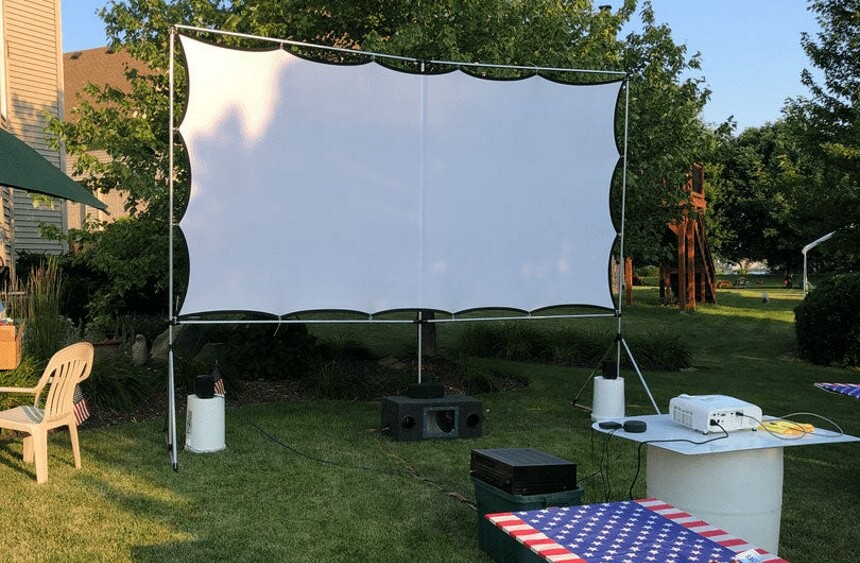
Aside from the weather, choosing a suitable time to view your film is critical. Of course, you would not want to restrict your viewing time to just sunrise, sunset, and late evening hours. These are, however, the periods that offer you the greatest chances of watching the movie without problems.
If you want to watch your movie during the sunniest or hottest hours of the day, especially between 10 am and 4 pm, you’ll need to use other techniques such as tents to increase the shaded zone.
While this might not be much of a problem over the winter months, you are more likely to use the projector during the sunniest months of the year.
During the sunniest months of the year, you’re more likely to utilize the projector outside. If your projector produces only 2,000 lumens, the sunlight that reaches it must be controlled.
It’s essential to clean the screen before mounting it or installing it on your patio wall. The screen you use together with your projector may become filthy and acquire a patina over time due to constant usage.
If this happens, it may be near-impossible to watch the film. Indeed, if the projector screen is of lesser quality than the picture on the wall behind it, colors and forms might be difficult to distinguish.
If you notice that the screen emits a strange odor, dampen it with lukewarm water. You may also use a mild, bleach-free, alcohol-free, and pH-neutral cleaner to restore the screen to its original condition.
The lumens of your projector is, without a doubt, the most crucial aspect to examine before purchasing.
Depending on the projector’s intended usage, you’ll need various lumens levels. If you want to use your new projector outdoors during the day, you’ll need a projector that can emit at least 3,000 lumens. If a projector has at least 5,000 lumens, it would be ideal.
However, most of the time, the more lumens a projector has, the more expensive it is.

After you’ve confirmed that your projector can produce the films you love, and it has adequate brightness to see the colors during the day, it’s time to check out the screen. To view a movie in your garden, you’ll need two essential device components: the projector and the screen.
The screen should be a reflective display for the projector to produce a 5,000 lumen light.
Reflective screens, which bounce backlight and offer more accurate, distinct, and vivid pictures for the audience to see, can combat sunlight and generate more accurate, precise, and bright images. While these features might be costly, they may genuinely help you enjoy your film outdoors during the day.
If you want to enjoy a film with your entire family, spouse, or friends, make sure they see it as well. However, some movie screens are only suitable for viewing if someone sits directly in front of the screen.
For more intimate nights when you and your spouse are simply sharing the experience, this sort of screen is ideal. But if you’re watching a show, game, TV series, or film with others, however, make sure the screen has a 160° viewing angle.
This technology allows people sitting in the back or along the screen’s edges to experience a film as if they were sitting in the middle of the screen.
If the projector supports it, find out whether the movie screen you’ve chosen includes it before making your purchase.
If you want to enjoy all of your favorite films and football games outside, there is a solution. Of course, you choose the sunniest and warmest days possible. However, it might be not easy if you don’t know where to begin when watching a film in your backyard.
Putting up an entire home theater is difficult, but investing in a strong enough projector to ensure good picture quality is crucial. Don’t forget the screen, which must be shaded, kept in place, and purchased with a console with a 160° viewing angle.
However, if you will be using the projector for other tasks such as presentations or gaming, then the higher resolution would likely make a noticeable difference in picture quality.
Some of the disadvantages of short-throw projectors include the fact that they are more costly than other types of projectors and may not have the same brightness.
A short-throw projector is a good choice for those who want a projector that’s simple to set up and takes up little space.
The Optoma UHD38 is a great daylight projector because of its high brightness and resolution. The contrast ratio is also amazing, and it can project an image size of up to 300 inches. This is definitely one of the best daylight projectors on the market.
The Samsung 120″ The Premiere LSP7T is an ultra-short throw projector that can give you a 120-inch screen in your living room. It comes with an Android TV operating system so that you can connect it to your WiFi and access all of the streaming apps. The LSPX-W1600 is expensive, but it’s a premium product that performs very well.
The Epson Home Cinema 3800 is the best resolution projector on this list and would be great for home theater use. It supports HDR (High Dynamic Range) for realistic image reproduction with vibrant colors. It is also versatile for a variety of spaces due to its throw distance. We highly recommend the Epson Home Cinema 3800 if you’re looking for a projector that will provide beautiful visuals in any lighting conditions.
